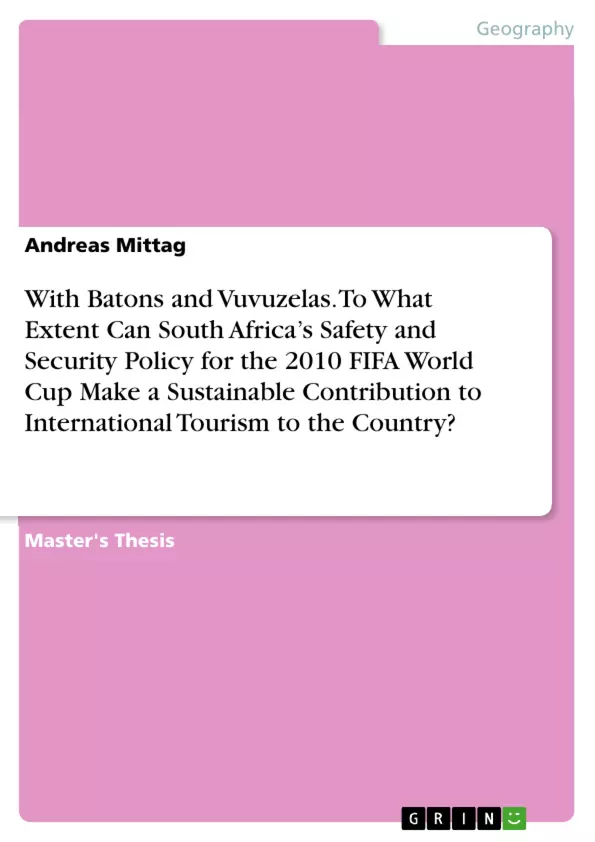This thesis examines the extent to which the safety and security policy implemented for the 2010 FIFA World Cup can make a sustainable contribution to international tourism to South Africa. Qualitative interviews were conducted with local experts from the fields of sport and recreation, safety and security, tourism and economic development in order to establish the effectiveness, sustainability and long-term impact of the 2010 safety and security plan on one of the country’s most significant and fastest growing economic sectors. The results of the empirical research reveal, amongst other things, that urban renewal and gentrification have rendered certain areas in South African cities more attractive and secure and that a comprehensive tourism safety network has been developed to cater for the needs of tourists. Finally, it can be concluded that the 2010 safety
and security policy’s sustainability cannot be guaranteed although its successful implementation will have improved global perceptions of South Africa as a tourist destination and have played a pivotal role in attracting future overseas visitors.
Diese Masterarbeit untersucht, inwiefern die Sicherheitspolitik im Rahmen der FIFA Fußball-Weltmeisterschaft 2010 einen nachhaltigen Beitrag zum internationalen Tourismus nach Südafrika leisten kann. Qualitative Interviews mit lokalen Experten aus den Bereichen Sport, Sicherheit, Tourismus und Wirtschaftsentwicklung wurden durchgeführt, um die Wirksamkeit, Nachhaltigkeit und längerfristige Bedeutung des Sicherheitsplans für einen der wichtigsten und zukunftsträchtigsten Wirtschaftszweige des Landes zu ermitteln. Die Ergebnisse der empirischen Forschung zeigen unter anderem, dass Stadterneuerung und Gentrifizierung gewissen urbanen Räumen mehr Attraktivität und Sicherheit verliehen haben und dass ein umfassendes Netzwerk für die besonderen Sicherheitsbedürfnisse von Touristen besteht. Es lässt sich schlussfolgern, dass
die Zukunftsfähigkeit der WM-Sicherheitspolitik zwar nicht gewährleistet werden kann, aber dass dessen erfolgreiche Umsetzung die weltweite Wahrnehmung von Südafrika als Reiseziel verbessern und somit einen wertvollen und langfristigen
Beitrag zum internationalen Tourismus leisten konnte.
Inhaltsverzeichnis
- Abstract
- Zusammenfassung der Kapitel
- Dedication
- Acknowledgements
- Chapter 1: Introduction
- 1.1 Research Problem
- 1.2 Aims and Objectives
- 1.3 Methodology
- 1.4 Delimitations
- 1.5 Theoretical Framework
- Chapter 2: Literature Review
- 2.1 Introduction
- 2.2 International Tourism and Sport
- 2.3 Security and Safety in Tourism
- 2.4 South Africa as a Tourist Destination
- 2.5 Conclusion
- Chapter 3: The 2010 FIFA World Cup and its Impact on Tourism in South Africa
- 3.1 Introduction
- 3.2 The Role of Safety and Security in a Mega-Event
- 3.3 The FIFA World Cup and Safety and Security in South Africa
- 3.4 Security Measures Implemented for the 2010 FIFA World Cup
- 3.5 The Impact of the 2010 FIFA World Cup on Tourism in South Africa
- 3.6 Conclusion
- Chapter 4: Sustainability of the 2010 Safety and Security Policy
- 4.1 Introduction
- 4.2 The Role of Urban Renewal and Gentrification in Ensuring Tourist Safety
- 4.3 The Development of a Tourism Safety Network in South Africa
- 4.4 The Long-term Impact of the 2010 Security Policy
- 4.5 Conclusion
- Chapter 5: Discussion
Zielsetzung und Themenschwerpunkte
This thesis aims to examine the extent to which South Africa's safety and security policy for the 2010 FIFA World Cup can contribute to the long-term growth of international tourism in the country. It investigates the policy's effectiveness, sustainability, and impact on one of South Africa's most vital economic sectors.
- The relationship between international tourism and mega-sporting events
- The role of security and safety in promoting tourism
- The impact of the 2010 FIFA World Cup on tourism in South Africa
- The sustainability of the safety and security policy implemented for the 2010 FIFA World Cup
- The contribution of urban renewal and gentrification to tourist safety
Zusammenfassung der Kapitel
Chapter 1: Introduction introduces the research problem, outlining the aims and objectives of the thesis, the methodology employed, and the theoretical framework used. The chapter also defines the scope of the research and the key concepts to be explored.
Chapter 2: Literature Review provides a comprehensive overview of existing research on international tourism, sport, security and safety in tourism, and South Africa as a tourist destination. It examines the theoretical frameworks underpinning the research problem and discusses the implications of previous studies for the current investigation.
Chapter 3: The 2010 FIFA World Cup and its Impact on Tourism in South Africa analyzes the role of safety and security in mega-events, particularly the 2010 FIFA World Cup. The chapter examines the specific security measures implemented for the event and assesses their impact on tourism in South Africa.
Chapter 4: Sustainability of the 2010 Safety and Security Policy focuses on the long-term impact of the security policy implemented for the 2010 FIFA World Cup. It explores the role of urban renewal and gentrification in improving tourist safety and examines the development of a dedicated tourism safety network in South Africa.
Schlüsselwörter
This master's thesis explores the intersection of tourism, sport, safety, and security in the context of South Africa's hosting of the 2010 FIFA World Cup. Key themes include the effectiveness and sustainability of security measures, the impact of urban renewal and gentrification on tourist perceptions, and the development of a comprehensive tourism safety network in South Africa.
- Citar trabajo
- Andreas Mittag (Autor), 2010, With Batons and Vuvuzelas. To What Extent Can South Africa’s Safety and Security Policy for the 2010 FIFA World Cup Make a Sustainable Contribution to International Tourism to the Country?, Múnich, GRIN Verlag, https://www.grin.com/document/366648



